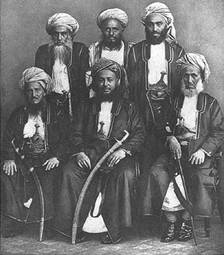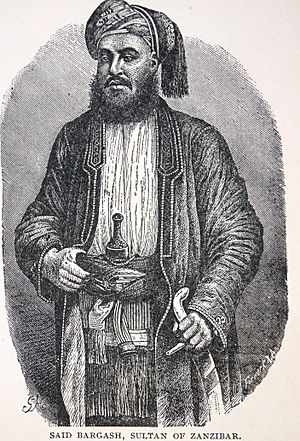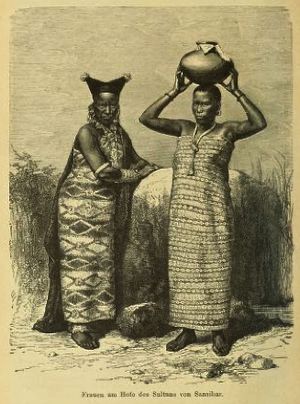Barghash bin Said of Zanzibar facts for kids
Quick facts for kids Barghash bin Saidبرغش بن سعيد (Arabic) |
|
|---|---|
 |
|
| Sultan of Zanzibar | |
| Reign | October 7th 1870 - March 26th 1888 |
| Predecessor | Majid bin Said |
| Successor | Khalifah bin Said |
| Born | c. 1836 |
| Died | 26 March 1888 (aged 50–51) |
| Dynasty | Al Said |
| Father | Said bin Sultan |
| Mother | an Ethiopian Suri |
Sayyid Barghash bin Said al-Busaidi (born around 1836 – died March 26, 1888) was an Omani Sultan. He was the son of Said bin Sultan and became the second Sultan of Zanzibar. Barghash ruled Zanzibar from October 7, 1870, until his death on March 26, 1888.
Contents
Early Life and Becoming Sultan
Barghash was born around 1836 to 1838. His father was Sultan Said bin Sultan, and his mother was Ethiopian. People described him as having a very sharp and charming personality.
Before he became Sultan, Barghash had some disagreements with his older half-brother, Majid, who was the first Sultan. At one point, Barghash was even arrested for treason and sent away to Bombay, India, for two years.
After his brother Majid passed away, Barghash became the Sultan in 1870. His time as ruler was very successful. He is known for building many important things in Stone Town, the capital of Zanzibar. These included pipes for water, public baths, a police force, new roads, parks, hospitals, and large government buildings like the famous House of Wonders (Bait el-Ajaib).
Barghash was perhaps the last Sultan who had real independence from European countries. He worked with European "advisors" who had a lot of influence. But he was still the main leader. He was clever in dealing with diplomats from Britain, America, Germany, France, and Portugal. He often managed to play one country against another to protect Zanzibar's interests.
Stopping the Slave Trade
The slave trade was a big issue during Barghash's rule. He had a treaty with the British to help stop it in Zanzibar. However, it was a difficult task, and he faced pressure from slave traders. British ships like HMS Daphne worked for years to free enslaved people in the Indian Ocean, especially near Zanzibar.
In 1873, a British official named John Kirk gave Barghash a strong message from Britain. The message said that the slave trade must stop completely, and the big slave market in Zanzibar must close. If not, Britain would block Zanzibar's ports. Barghash agreed within two weeks. He signed another treaty with Britain that banned the slave trade in his kingdom. He immediately closed the large slave market.
Challenges from European Powers
Towards the end of his rule, Barghash saw his empire start to shrink. In 1884, a German adventurer named Carl Peters made deals with African chiefs on the Tanganyika mainland. These deals put their areas under German "protection." In 1885, the German government officially approved these new claims.
Soon after, German traders made a deal with the Sultan of Witu on the Kenya Coast. This area also came under German protection. Barghash tried to send troops against the Witu ruler, as he believed Witu was part of his lands. But a German fleet arrived, forcing him to accept the German presence.
In 1886, Britain and Germany made an agreement. This agreement recognized Barghash's rule over a narrow strip of land along the coast. However, this agreement did not last long. It made it hard for Germany to reach the sea from its new territories.
Barghash died before a new agreement in 1888 came into force. This agreement gave the coastal strip of Tanganyika to the Germans. This led to an uprising by the Sultan's people against the Germans, which was later put down.
Barghash's son, Khalid, later tried to become Sultan in 1896. But he was removed from power after refusing a British demand. This led to the Anglo-Zanzibar War, which lasted only 40 minutes.
Honours
- Grand Cross of the Order of the Tower and Sword of Portugal (GCTE) 1875
- Grand Cross of the Order of the Red Eagle, 1st Class in brilliants of Prussia 1875
- Grand Cross of the Legion of Honour 1875
- Knight Grand Cross of the Order of St Michael and St George (GCMG) 1883
Sources
- Ruete, Emily, (1888): Memoirs of an Arabian Princess from Zanzibar (Many reprints)
- Ruete, Emily, Ulrich Haarmann (Editor), E. Van Donzel (Editor), Leiden, Netherlands, (1992): An Arabian Princess Between Two Worlds: Memoirs, Letters Home, Sequels to the Memoirs, Syrian Customs and Usages. Presents the reader with a picture of life in Zanzibar between 1850 and 1865. ISBN: 90-04-09615-9
| Preceded by Majid bin Said |
Sultan of Zanzibar 1870–1888 |
Succeeded by Khalifah bin Said |
See also
 In Spanish: Barghash ibn Said de Zanzíbar para niños
In Spanish: Barghash ibn Said de Zanzíbar para niños




